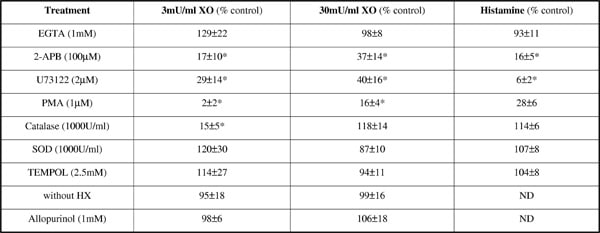Xanthine oxidase (XO) catabolises the conversion of purines to uric acid and hypoxanthine (HX)-XO has been used to investigate endothelial cell (EC) cytoplasmic calcium ([Ca2+]c) responses generated to both superoxide and hydrogen peroxide (H2O2)1,2. The aim of this study was to investigate [Ca2+]c responses to HX-XO in human vascular ECs isolated from the saphenous vein (SV) and compare responses to other studies. ECs were isolated from SV obtained surplus to bypass surgery. Cells grown to confluency on glass coverslips were loaded with fura-2. [Ca2+]c responses were recorded to 3 or 30mU/ml bovine buttermilk XO (Sigma, UK) in the presence of 2mM HX. Histamine (10μM) was used as a comparator. Data are presented as mean±s.e.m. SVECs responded to XO with [Ca2+]c responses of 244±38nM at 3mU/ml and 345±55nM at 30mU/ml (n=5). XO-HX gave an initial peak [Ca2+]c response followed by either calcium oscillations or a sustained [Ca2+]c elevation. Histamine gave a [Ca2+]c response of 683±68nM (n=5). EGTA abolished the sustained phase of the response to both XO and histamine but the peak [Ca2+]c response and oscillations were maintained. Inhibition in the presence of 2-aminoethoxydiphenyl borate (2-APB), U73122 and phorbol 12-myristate 13-acetate (PMA) demonstrated that the XO-induced [Ca2+]c response in SVEC was mediated by the generation of inositol 1,4,5-trisphosphate and was sensitive to protein kinase C activation. The presence of high levels of catalase but not superoxide dismutase (SOD) or 4-Hydroxy-2,2,6,6-tetramethylpiperidine 1-oxyl (TEMPOL) reduced the XO mediated [Ca2+]c response. However XO-mediated [Ca2+]c responses were maintained even in the absence of HX or the presence of allopurinol, which both abolished XO activity. In conclusion, the HX-XO [Ca2+]c response in SVEC occurs independently of enzyme activity. As our results are similar to those of other investigators using XO to measure superoxide/H2O2-mediated EC [Ca2+]c responses1,2 previous results may need to re-interpreted.
Life Sciences 2007 (2007) Proc Life Sciences, PC491
Poster Communications: Xanthine oxidase-mediated calcium responses in human endothelial cells occur independently of enzyme activity
A. R. Conant1, E. E. McCarron1, W. C. Dihmis1, A. W. Simpson2
1. Research, The Cardiothoracic Centre, Liverpool, United Kingdom. 2. Dept Human Anatomy and Cell Biology, University of Liverpool, Liverpool, United Kingdom.
View other abstracts by:
Table 1
Where applicable, experiments conform with Society ethical requirements.

